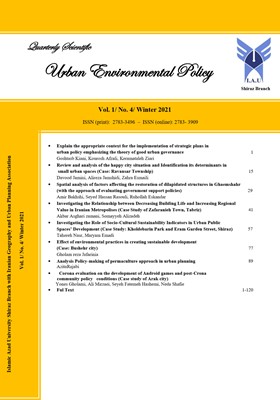تبیین زمینه مناسب تحقق طرح های راهبردی در سیاست گذاری شهری با تأکید بر نظریه حکم روایی خوب شهری
الموضوعات :
گشتاسب کیانی
1
![]() ,
کوروش افضلی
2
,
کوروش افضلی
2
![]() ,
کرامت الله زیاری
3
,
کرامت الله زیاری
3
![]()
1 - دانشجوی دکتری شهرسازی، واحد کرمان، دانشگاه آزاد اسلامی، کرمان، ایران
2 - استادیار گروه شهرسازی، واحد کرمان، دانشگاه آزاد اسلامی، کرمان، ایران
3 - استاد گروه جغرافیا و برنامهریزی شهری، دانشگاه تهران، تهران، ایران
الکلمات المفتاحية: طرحهای راهبردی, تئوری زمینه ای, تحقق پذیری,
ملخص المقالة :
امروزه فضای شهرهای جهان سوم منجمله ایران تبدیل به فضایی مشکل زا شده و کیفیت زندگی در متن این فضا را تنزل داده است. همچنین برنامه ریزی و مدیریت شهری نیز نتوانسته است جهت توسعه این فضاها موثر باشد بطوریکه زایش و مشکل زایی این فضاها ادامه دار گشته است. یکی از مسائل برنامه ریزی شهری در این شهرها، فراهم نبودن بستر لازمه جهت اجرا و تحقق، طرحها و برنامه های نوین توسعه شهری می باشد. بطوری که این طرحها و برنامه ها همواره با عبارت عدم تحقق روبرو می گردند. این موارد فرایند مدیریت و برنامه ریزی شهری در این شهرها را از توسعه محور بودن به سمت ساماندهی محور بودن سوق داده است. چرا که به علت فضای مشکل زا و فراهم نبودن زمینه، برنامه ریزی شهری نمی تواند به تحقق طرحهای توسعه شهری منجر گردد و تنها می تواند به ساماندهی مشکلات شکل گرفته در متن فضایی موجود بپردازد. یکی از این طرحهای نوین توسعه شهری، طرحهای راهبردی می باشند که در زمان مدرنیته مطرح شده است. مطالعات صورت گرفته نشان می دهد که طرحهای راهبردی نیز نمی توانند در متن فضایی شهرهای ایران، محقق گشته و به اهداف خویش برسند. روش کار در این پژوهش روش گرند تئوری یا نظریه ای می باشد، نوشتار حاضر سعی در تبیین این مسئله دارد. یافته های نوشتار با رویکرد پدیدارشناسی هرمنوتیک نیز نشان می دهد که عدم سازگاری زمانی – فضایی و محتوایی، مهمترین عامل عدم تحقق طرحهای راهبردی در شهرهای ایران می باشد. بطوریکه تحت تأثیر این عدم سازگاری، متن فضایی شهرهای ایران زمینه لازمه را جهت خوانش و انتقال معنا (تحقق) طرحهای راهبردی، دارا نمی باشند. با توجه به تئوری زمینه ای، متن فضایی سازگار جهت تحقق طرحهای راهبردی، از طریق وارد شدن به دوران موسوم به مدرنیته، فراهم می گردد. در حالیکه متن فضایی شهرهای ایران، تحت تاثیر زمانه گذار بین سنت و مدرنیته شکل گرفته و این زمانه در مرحله بعد پدیدار عدم سازگاری فضایی و محتوایی را شکل می دهد که سبب فراهم نبودن زمینه جهت تحقق طرحهای راهبردی برای توسعه شهرهای ایران می گردد.
_||_


